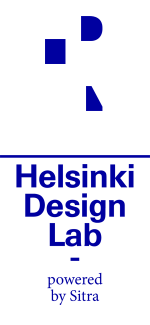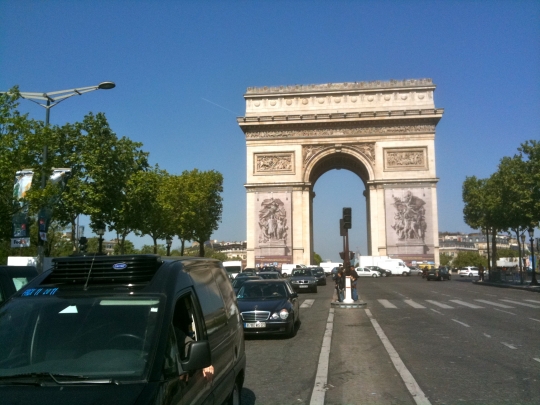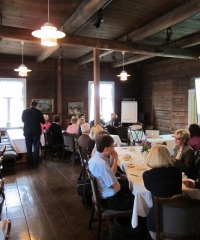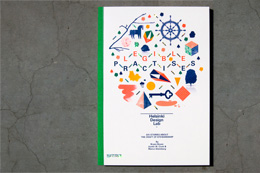Weeknotes
Summer is in full swing here in Helsinki, which means that things are slow. Well, things are slow everywhere but HDL. Marco and I continue to narrow in on HDL Global, taking advantage of the empty calm of the office to talk through some scenarios without having to slice the conversation into between-meeting-sized chunks.

A temporary fruit orchard built in the heart of London as temporary nursery for plants and trees which will ultimately be gifted to local schools and community groups. Also home to Aalto University's Nest, sponsored by the Finnish Institute.
I started the week in London, where I was visiting the London Festival of Architecture to share some thoughts about design, complexity, and decision making informed by our work here at HDL.
Back in Helsinki we have things on the burner: working with XOXCO on a new part of this website, which will be helpful for sharing the work of the HDL Studios as well as supporting Studio-style work in the future; walking through HDL Global step by step with Emil+Stephanie to make sure that signage and printed material is designed for all of the needs, navigational, informational and otherwise; setting up contracts and schedule for some video work to kick off in early August; on the horn with Zurich to explore a potential new avenue for HDL.
We also put up a ton of images on Flickr. Over the next week we'll trickle some of those photos on the blog, but if you just can't wait to see you can find shots from all of our HDL Studios, most of which are by the talented Ivo Corda.
A quick note from the week of juhannus in Finland, where the length of the days reach their maximum for the year and many people take a holiday.

This is what Helsinki looks like at 01:00 on juhannus. Photo: Maanmatonen on Flickr
We've begun a new series of posts that reflect on the HDL Studio experiences from this summer. Check out the first two bits on building the right team and making the most out of a single week. Up next we'll have a post on knowledge transfer, to be followed by further posts on the all the behind the scenes work that goes on to support the studios.
Work continues on many fronts. Amongst them: zeroing in on September, starting a new project related to this website, and continuing to scope out the evolution of HDL.
Goodbye, June!
This update comes from somewhere over the middle west of the United States, as I type away thanks to inflight wifi. Marco, Justin, and I have been in San Francisco for the Design Management Institute's Re-Thinking the Future of Design conference. Largely focused on the effectiveness of an expanded use of design within commercial organizations, Marco was sharing our work on a panel with Kyung-Won Chung from the Mayor's office in Seoul, South Korea, as well as Bruce Nussbaum, Roger Martin, and Jeanne Liedtka that discussed design in a larger societal context.
The event had a pretty good Twitter feed going and there were lots of lively discussions. The crowd skewed towards a more experienced, and thus older, level of individuals but it was nice to see some young faces in the audience as well. My eyes are especially attuned to these kind of demographics when I visit events these days.
With the HDL Studios and now HDL Global we've made a conscious effort to make space for younger voices in the conversation. Not only is the youthful perspective important, but we want to create opportunities to expose them to a new way of working and a new set of tools while they have an entire career ahead of them.
Speaking of students, this week concludes the work of Anna-Leena and Christina who have been supporting the ageing studio. Rather than work part time for a month, they compressed their work into a focused week-long charrette, which might explain the "brain self portraits" they drew.

Not sure what this says about HDL, but it's a fun exercise to draw a brain self portrait. Give it a try!
While in San Francisco, Justin and Marco managed to sneak in a couple Low2No working sessions with Arup and I paid a visit to Adaptive Path, where I had a chat with Peter Merholz about his growing design consultancy, and global design practice in general.
It was a good week and now we begin our laser focus on getting ready for September.
Last week was the HDL Studio on Ageing, our third and final for 2010. It was a lively, intellectually powerful five days spent in Helsinki and Jyväskylä and a perfect endcap to the HDL Studios experience. Here's a glimpse of our 2010 Studios by the numbers:
- 1 studio space
- 6 weeks
- 3 studios
- 24 studio Members
- 17 of which came from abroad
- 2 combined count of volcanos and labor strikes that our travel plans managed to survive without incident
- 7 studio assistants
- 25 guest speakers
- 7 Sitra organizers (either full or part time)
- 9 fieldwork visits by the studios
- 13 "final review" guests
- 18 group dinners
We'll be spending the next couple months wrapping up the work of the studios and determining the best way to proceed. If you're curious about the outcomes, please check back here, subscribe to our RSS feed, or follow us on Twitter. As soon as we have concrete news, it will be posted to this site.
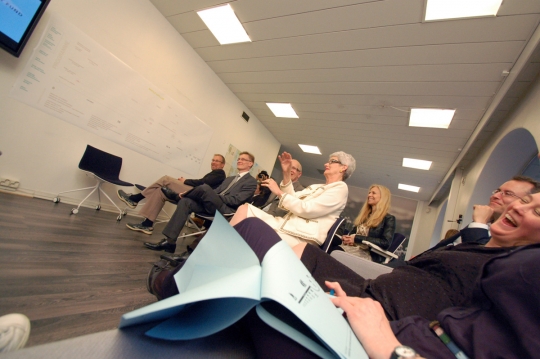
A snapshot from the Ageing Studio final review
With the studios now behind us, we've accumulated a body of strategic knowledge relevant to the three thematic topics of ageing, sustainability, and education, but we've also learned a lot about how one practices strategic design. During the summer months I'll be sketching out some basic thoughts about the experience and we'll hopefully have some guest blog posts from a few of the studio members as well. If you're interested in how to organize and operate a focused, fast, collaborative strategic environment stay tuned!
Since Helsinki Design Lab was re-calibrated as an initiative to foster 'government meets design' we've had three initial mini-projects. The first was this website, the second were the HDL Studios, and now our sights are set on HDL Global 2010, an invitational event this fall. So, in other words, tomorrow. Not that we're feeling the pressure or anything.
We've started to get a few little bits of press. The Talouselämä interviewed Darrel Rhea (printed in Finnish) when he was here for the Studio on Education. Linda Nathan wrote about the same week on her blog. Elsewhere, The World Changing Blog had some very nice things to say about us. We like you too, World Changing. And if you're the visual sort, Dan Hill has posted a whole heap of photos from his time in the HDL Studio on Sustainability.
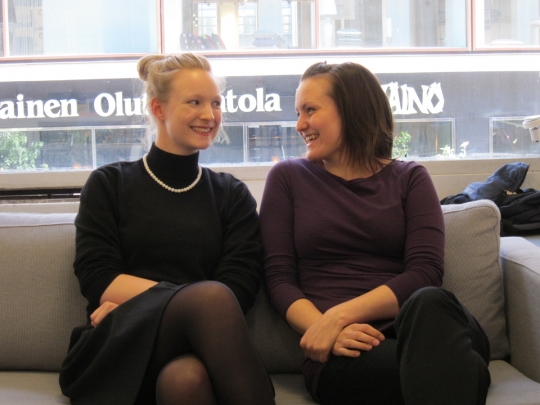
Taru and Kristiina were suspiciously happy about their last day at HDL.
All that's left for this week are some very important thank yous. Taru and Kristiina, two Aalto students who were the research team for the sustainability studio have completed their work, so we say thank you and goodbye to them. Thanks also to Adriel and Ezra, who longtime readers will remember as the primary researchers of the Challenge Briefings for our Ageing and Education studios. And finally, a very big thanks to Hanna, Minna, Sanna, Miku, and Seungho for their continuing contributions to the project. Without such a great team offering logistical, practical, and psychological support there's no chance that the HDL Studios would have come off as well as they have.
When planning the HDL Studios we intended to have a two week gap between each. In the end, the schedule wiggled around a bit and we ended up with the HDL Studio on Sustainability and the HDL Studio on Ageing separated by only one week. Judging by the facial expressions I saw while looking around during our final prep meeting for the ageing studio, the difference in prep time is, in fact, no small difference. In honor of the hectic week, let's keep this short, sweet, and mostly photographic.
Taru and Kristiina began the wrap up work for the sustainability studio. This involves reviewing the tapes of the final presentation, transcribing all the stuff from the walls, and beginning to collate the two. Ultimately this will result in a document which summarizes the 'final review' of the studio and supports it with further information that was discussed early in the week but just couldn't fit into the final conversation.
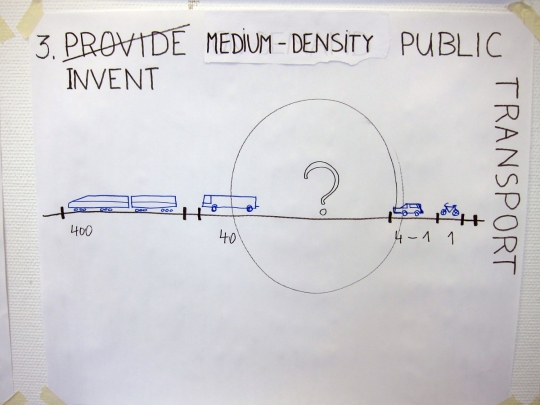
One of the paper "slides" from the sustainability studio, proposing one of ten action areas.
Alongside this work is a project to map the decision making territory around carbon. Who are all of the parties at the municipal, national, EU, and supranational level that have a decision making role affecting carbon? This is no small task and the research assistant teams have been fearlessly wading into the morass as they attempt to sort it out. When we started, I asked them to "draw the org chart of the problem," but now I see that this is more or less impossible: it's more of a disorg chart. These are huge messy tangles of relationships and it has been a very juicy challenge to sort it all out.
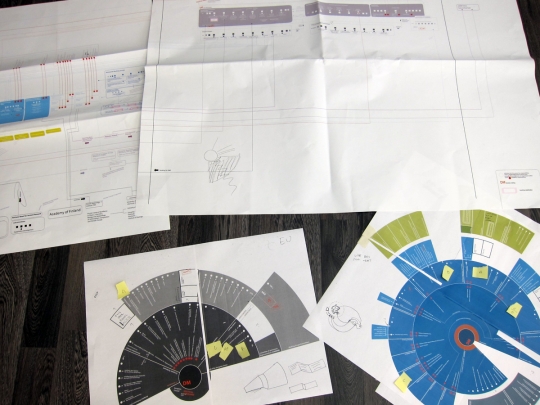
Working on a map of the decision making structure of climate change. The typical "org chart" style seen at the top has been abandoned for a radial arrangement in recognition that this situation is anything but organized.
Elsewhere in the studio, Christina and Ankki are at an earlier stage of a similar process, only their focus is on ageing rather than carbon. They started out with a pencil sketch, which is always a good idea.
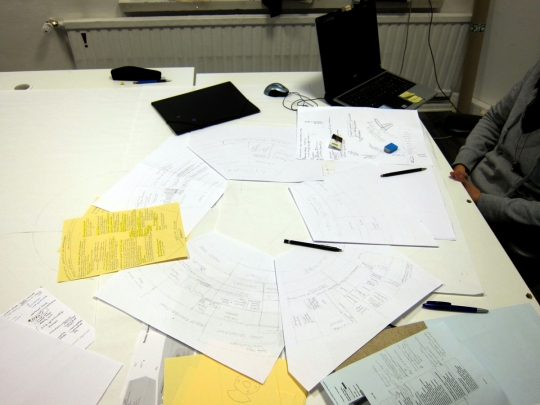
The decision making map for ageing in Helsinki is shaping up.
Just as the ageing studio is about to begin, the education studio is being fully wrapped up. Johanna and Rodrigo put in their last day of work as research assistants at HDL. Although their work on the education studio is over, we're still in the early stages of a larger arc of work to discover how the outcomes of the studio can be best applied. In fact, on Thursday we hosted some folks from the City of Helsinki to see if there's a possibility of collaborating on their work related to supporting immigrant students.
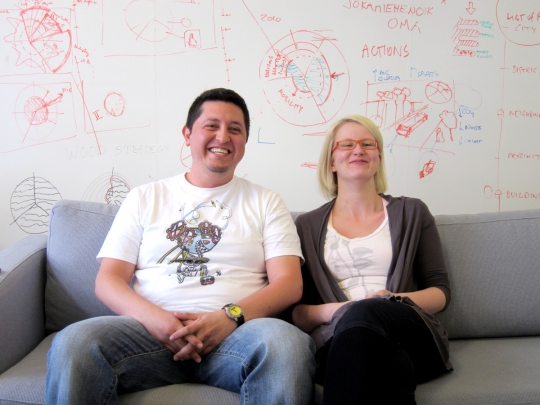
Rodrigo and Johanna completed their the education studio wrap up work today. It's been great to work with them, and we wish these two luck in whatever they pursue next.
This week Seungho also introduced us to a bit of his student work at Aalto University in a pair of posts (one, two) about Cambodia. He has promised to check in again with some of the outcomes of the semester, including a strategic framework to rethink the role of NGOs in that context.
So with that we will say goodbye to Week 065, as well as thank you to Johanna and Rodrigo.
During week 064 we tested the limits of the human brain by subjecting the eight members of the HDL Studio on Sustainability to an intense week of work. Like the Studio on Education before it, this was a rewarding week that left all of us energized to continue our work on these topics but desperately in need of a few days to decompress.
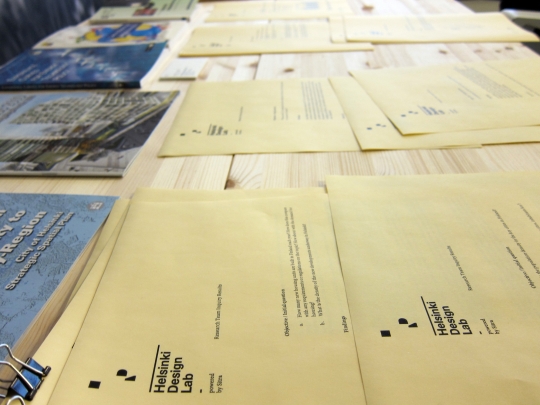
An array of research inquiry memos laid out on the "science lab table" in the studio. Supporting the studio members is a team of three research assistants who track down answers to questions and fix appointments. As the week wore on this table filled up.
For the final "review" we were joined by Mikko Kosonen, President of Sitra; Jukka Noponen, Director of Sitra's Energy program; Peter Lund, professor at Aalto and one of Finland's top experts in energy policy; Timo Mäkelä from the EC's Environment Directorate-General; and Helena Säteri, Director General of the Ministry of the Environment in Finland.
The conversation was wide-ranging but one major theme was the question of how to enable cross-ministerial action on sustainability, rather than just talk. As the studio heard from different stakeholders over the course of the week there are many cooperative relationships between the ministries and other key bodies, but these are generally non-binding. They have no teeth. The studio wondered if a "war on carbon" and a matching war cabinet be the right approach.
For now I'll leave you with that juicy tidbit and we'll check in later with the full outcomes, once the work has been transcribed and formatted in a sharable manner.
Wondering what the studio activities look like? Here's a video of five completely packed days compressed into 18 seconds. Looks easy, right?
While the Sustainability studio was ongoing, the HDL team was busy fixing last minute logistics for our next Studio on Ageing that begins in just six days, as well as continued effort on HDL Global 2010.
Justin had to duck out for a few days to attend a Low2No design meeting in London. While we were sad to have him gone in the middle of the Sustainability Studio, it's very exciting to watch Low2No begin to shape up.
What else?
Darrel Rhea wrote up his experience of the Studio on Education over at the Cheskin blog. We showed up in the Social Innovator methods index created as a collaboration between the excellent folks at NESTA and the Young Foundation. And did you know that you can follow HDL on twitter at @HDL2010?
It's already the wee hours of Monday, so technically this weeknote is being written on the first day of the HDL Studio on Sustainability. Tonight we welcomed the team to Helsinki with a quick dinner at Kuu Kuu before sending everyone back to the hotel to rest up in preparation for the quixotic week ahead.
Since we're at the very beginning of the week, let me introduce the studio:
- Alejandro Aravena. Executive Director, Elemental, Chile
- Dan Hill. Senior Consultant, Arup, Sydney (and prolific blogger)
- Janne Hukkinen. Professor of Environmental Policy, Helsinki University
- Seppo Junnila. Professor of Real Estate Business, Aalto School of Science & Technology
- Patricia McCarney. Director, Global City Indicators Facility, University of Toronto
- Federico Parolotto. Senior Partner, Mobility in Chain, Milan
- Matthias Rudolph. Project Leader, Transsolar, Stuttgart
- Katharina Schmidt. Masters of Spatial Design Student, Aalto School of Art & Design
This talented bunch will be spending the next five days with in Helsinki where their mission is to begin unpacking the complexities of carbon neutrality for Finland and to think about what a roadmap to carbon neutrality would look like.
One question we often get is "how do you pick the studio teams?" During the HDL Studio on Education someone went so far as to say that they felt like they were participating in an Agatha Christie novel: a group of people are mysteriously pulled together out of thin air—why are they here and what will they do now?
So, a few brief words describing our best guess as to how you build a successful team for this kind of work. To begin, it's important to know that as the research for the Challenge Briefings developed, we created expertise profiles for each studio. These were running lists that identified what we consider to be key perspectives for each studio topic.
In Sustainability we knew that building physics, transit, and policy would be essential areas, for instance. These are quite predictable. But we also sought some perspectives that might at first be unexpected. The thought behind this is simple: if you only include the regular suspects you will only get regular results.
Here are the basic rules of thumb that we used when thinking about the mix of the team and how to select the right individuals:
Keep it small: With too few people there's a danger that conversation will not be robust enough, but with too many people in the room it's difficult to have a single conversation. Based on experience, and a bit of advice from Dan Goldin, a team of eight is optimal. This has worked out very well for us. Some things work well in large groups, but strategy sessions are not one of them.
No room for duplicates: The studio team will be working quickly, which means that the collective expertise and experience in the room is the team's largest asset. Although team members may have some overlaps in their interests, it's best if each member is the master of their own domain and offers serious, focused expertise about their field. Each member becomes a 'representative' of their expertise and no one is redundant.
Only accept the best: When it comes to selecting individuals, we've gone straight to the top. Across the board, we feel that the studio members we've attracted are either at the top of their respective fields or upcoming talents. High quality input may not quite guarantee high quality output, but it's certainly a prerequisite.
Flexible expertise: It doesn't matter if you're the top expert on the planet in subject XYZ unless you're able to relate to others and convey your ideas in an open, productive manner. For this reason, we look for people who are at the top of their field, know their material inside and out, but are also naturally curious about the world around them, and able to sociably entertain models that conflict with their own.
Be (a bit) local: One of the great strengths of the HDL Studio format is that it offers a very fast and focused infusion of international expertise. But bringing in a wholly international group can lead to fruitless conversations when the cultural context is not understood. We set a rule of thumb for ourselves that two of the studio members would be Finns so there would always be 'cultural ambassadors' in the core team.
Design is the glue: Each of the studios have two designers who work as facilitators amongst a group of peer-experts. It's their job to ensure that the conversation is balanced and holistic. Only a particular kind of designer will work in this context. They need to be able to apply their training to strategic issues.
If these are the rules that guide our choices, one might ask how we first narrow the field. So far, the best indicator we have is that the kinds of people who succeed in collaborations with HDL are those who have significant experience in multiple cultures. Marco likes to use the term Third Culture Kid. This may be "culture" as it's typically defined or it may also refer to different cultures of expertise or work.
If I have the choice between an expert in astrophysics and an expert in astrophysics with a previous background in agriculture, my bet is on the latter. There's something about having lived in multiple cultures that prepares an individual for the kind of lateral thinking that is required in an HDL Studio.
Finally, the mix of the studio in terms of both expertise and personality is important. While one my be able to judge an individual's expertise by broswing a CV and reading some publications, it's very difficult to assess whether an individual will work well as part of a team unless you meet them in person. Sharing a phone call works too, but it's not as effective as having a face to face conversation with someone.
For all of these reasons listed above, we devote a lot of time to sketching out the right mix for a team, courting a qualified pool of invitees, and working to secure their participation. By way of example, the process of defining the HDL Studio teams began eight months before the first studio.
Editor's note: These reflections on developing the HDL Studio Teams have been updated in a new post here.
Which brings us to the end of this rather long weeknote. It was full of powerpoints: Marco spent Tuesday in Valamo, where he gave a presentation the Valamo Monastery's seminar on Divinity and Truth, and then closed the week as a respondent on a panel entitled "Helsinki – an Open and Cosmopolitan City?"
Meanwhile, I was in Paris to attend the SIX Spring School, to share our work at HDL, and to continue digging in to the ageing content in advance of our own Ageing studio which will happen in June. Thanks Geoff, Louise, and everyone else for a great event!
Hearing from each of the studio members as they made their way home last week, it sounds like it was an exhausting and exhilarating time for everyone. It has been more than a week since the HDL Studio on Education ended and personally I'm just now getting back to the normal routines of life.

Friday. A group discussion after the studio presented its findings and recommendations
Last time we checked in on the Education studio they were in the throes of developing a synthesized position on the education challenge. That work continued through the morning and afternoon on Friday and then we ended the day with a discussion between the studio, a number of people from Sitra, Timo Lankinen of the Finnish National Board of Education, and Maruja Gutierrez-Diaz of the European Commission. It was great to have such a high powered conversation in a group small enough that we could really dig into issues, a discussion that continued over dinner in the studio with the work of the week pinned up on the walls around us.
The question is: what next? One of the difficulties of the work of HDL and Sitra more broadly is that we're in the business of creating opportunities. Sometimes this means helping two organizations or individuals meet and discuss areas of possible collaboration; sometimes this means helping foster new business ventures, as Sitra's venture capital operation is well versed in; sometimes it means introducing new ideas into Finland, like the ways that Low2No has contributed to the discussion about sustainability; and sometimes it means creating space for reconsidering challenges from a new point of view.
So back to that question of what's next. From here we will continue the conversation with Timo and his colleagues, as well as our partners at the Ministry of Education, and other groups which are keen to learn more about the outcomes of the studio. In short, we're going to follow the opportunities as they arise—and we'll try to nudge a few along too.
Of course we have a couple ideas of what's next, but if we gave away all of our plans where would the fun be in that?
Besides feeling like a pack of exhausted zombies, this week was spent ramping up our next studio on sustainability while ramping down the studio on education. Ramping down involves transcribing the whiteboards, photographing everything, and reviewing the tapes of the final conversation. Ramping up involves continued work tracking down answers to questions that the studio members have sent in advance, so that they can hit the ground running.
And what else? It's spring, so we got some new flowers!
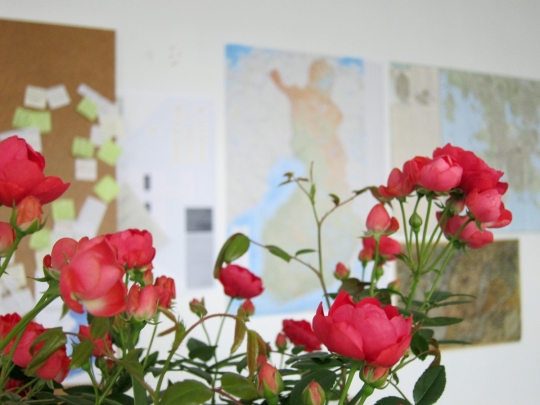
Actually, OK Do brought us the flowers. Thanks!
We continued the sprint to wrap up the final details of preparing the studio space for our first guests. This involved lots of tiny things like getting the our name on the sign downstairs and finding a good water pitcher. Seungho took care of these with aplomb.
Meanwhile, Rodrigo and Johanna have been wading through piles of official documents and lots of phone calls to continue their work drawing out the organizational chart of the education system. This sort of work very easily turns into spaghetti, so we've been taking it slow. Part of the ramp up phase for the studio assistants is a nice dinner to get to know everyone. Annikki and I had the pleasure of taking the Sustainability Studio and the Ageing Studio to dinner this week which means that all three teams have officially booted up.
Marco, Hanna, Annikki, and I spent Thursday in Jyväskylä, where Sitra sponsored a workshop with a wide cross section of stakeholders who deal with issues relating to the elderly in that city. We heard a bit about some of the challenges of delivering care to a broad variety of different groups of people. One of the key issues in Jyväskylä, as well as the rest of Finland, is that it includes a dense urban core as well as vast expanses of lightly populated rural areas. Delivering equal levels of care to people in such disperate physical environments becomes a tricky proposition. This was preliminary work for the Ageing Studio which happens in early June.
And tonight things suddenly became very real. Marco and I met the Education Studio members who've just flown in from Singapore, London, San Francisco, Boston, as well as the two locals from Helsinki, and took them out to a neighborhood dinner in Töölö. Shaking the hands of these excellent people who've come to spend a week with us really underscored the fact that, oh yeah, this thing we've been planning for over a year begins tomorrow!
With just a few short days before the first studio guests arrive, we're in loppukiri ("final sprint") mode.
Seungho, Minna, Sanna, and Hanna have been handling all sorts of last minute items for the studio. We now have furniture, a full wall of whiteboard writing surface, internet access, a conference phone that looks like a space ship, and – most importantly – an account at the cafe next door.

Still rough around the edges, but getting there.
The instant we had furniture the studio assistants for our Education Studio were already powering full steam ahead. Rodrigo, Johanna, and Annikki have been covering a lot of ground as they research and map out the territory of education in Finland. Who are the key actors and what are the relationships between them? How are these institutions, organizations, and entities structured? Sunday is when the eight members of our studio arrive, so this work is not a minute too soon.
With May just a few days away, we ended the week with an all-hands meeting to review HDL Global 2010. The crowd grew from 10 to 12 as we welcomed Emil+Stephanie to present their work on the visual identity. The event plans are generally shaping up but there's still a lot to nail down, which is why Marco has been on the horn with Moscow, Washington, and many points in between.
Oh, and we launched the new website.
Feeling good about the accomplishments of 059, but already half way through week 060, it's time to turn up the Piazzolla and get back to work.
